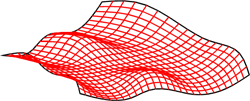
Today modern product designs have increasingly complex and sophisticated surface structures. Whether household goods, furniture or car bodies, many of these products get their design by arbitrarily curved surfaces defying analytical description. Such surfaces are called Freeform Surfaces. HiCAD provides the appropriate technology for the creation and processing of such surfaces.

Example of a Freeform Surface

Examples of Freeform Surface-based designs
Special mathematical procedures are used to describe Freeform Surfaces, based on a quantity of control points, with each control point corresponding to a 3-D point. If the calculated freeform surface coincides with these 3-D points, the procedure is called "interpolation". If the surface only gets close to these 3-D points, the procedure is called "approximation". Possible is, for instance, the creation of
Freeform surfaces are always generated in the same way:
Each freeform surface is represented via the calculated points of a curve which are connected by straight lines. The number of points can be preset by the (n,m) parameter values. The greater the number of parameter values, the more precise and detailed will be the representation.
Before generating a freeform surface, create a new drawing or load an existing drawing.
You will find the functions for the generation and processing of freeform surfaces on the 3-D FFS tab. The functions for creation and processing of freeform curves are available via the Sketch tab.
HiCAD offers the following procedures for generation of freeform surfaces:
Furthermore, freeform surfaces are also created during filleting of 3-D parts. Internally, a freeform surface is always saved as B-spline surface, respectively a a NURBS, even if it has been created as a cubic spline surface or an Akima spline surface. This is important for the modelling of freeform surfaces, as only B-spline surfaces, respectively NURBS can be modified locally.

Overview of Functions • Information on Freeform Surfaces
|
© Copyright 1994-2018, ISD Software und Systeme GmbH |